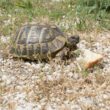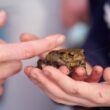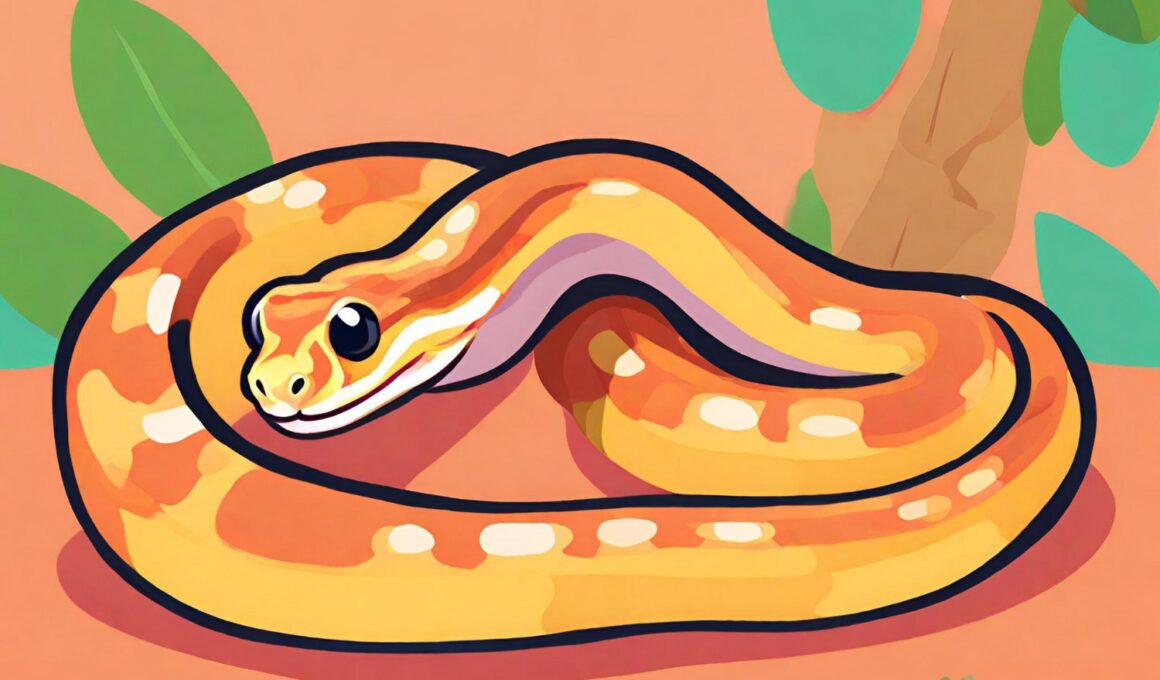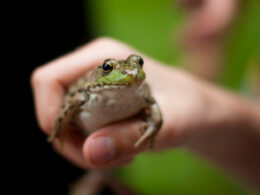In this article Show
For many, the journey into reptile ownership begins with the allure of the Ball Python. These creatures, with their calm demeanor and fascinating range of morphs, have steadily gained prominence in the hearts of reptile enthusiasts and beginners alike. But like any pet, they come with their set of unique care requirements.
As someone who’s spent countless hours understanding the intricacies of various reptiles, I’ve come to appreciate the importance of proper care in ensuring a thriving, healthy life for our slithering companions.
Ball Pythons, while being relatively low-maintenance compared to some other exotic pets, demand an understanding of their specific needs.
In this comprehensive guide, we’ll navigate through the essentials of Ball Python care, from selecting the right one for you to understanding their dietary needs and habitat preferences.
Let’s embark on this journey together, ensuring that your Ball Python not only survives but thrives under your care.
Choosing Your Ball Python
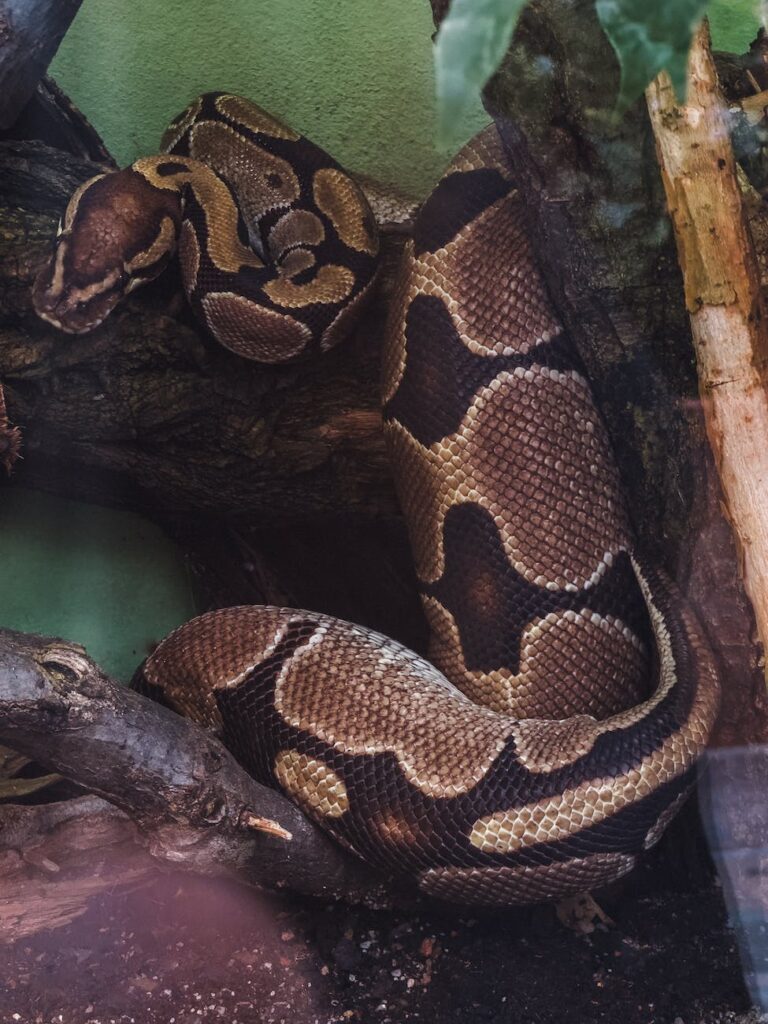
One of the most captivating aspects of the Ball Python is its stunning variety of morphs and colors, making the selection process not just about health but also personal aesthetic preference. However, choosing the right Ball Python goes beyond aesthetics—it’s crucial to ensure you’re bringing home a healthy and well-adjusted snake.
Deciphering the Wide Range of Morphs and Colors
Ball Pythons offer an impressive array of morphs, each with its unique pattern, color, and appeal. From the classic wild-type to the exotic Piebald or the Ghost, the possibilities seem endless.
For beginners, it might seem overwhelming, but with a little research, you can find a morph that resonates with your preferences. Keep in mind, however, that the rarity of a morph can influence its price.
Key Indicators for Selecting a Healthy Snake
When selecting a Ball Python, it’s paramount to ensure it’s in optimal health. Here are some signs to look for:
- Active and Alert Eyes: Cloudy eyes might indicate an upcoming shed, but dull or sunken eyes can be a sign of health issues.
- Firm, Well-rounded Body: The snake should be robust and free of any visible lumps or bumps.
- Smooth Scales: Apart from the natural shedding period, the snake’s scales should be smooth and free from mites or injuries.
- Responsive Behavior: A healthy Ball Python will be alert and responsive to its surroundings, showing curiosity without excessive aggression.
Breeders vs. Pet Stores: A Critical Decision
Choosing where to purchase your Ball Python is a decision that carries long-term implications. While pet stores might offer convenience:
- Breeders: Often specialize in Ball Pythons, ensuring you get a snake that’s been well-cared-for and properly socialized. They can provide specific lineage information and insights into the snake’s history and care.
- Pet Stores: Might offer a wider variety of snakes, but they often lack the specialized care or detailed history that breeders can provide.
According to a study in The Herpetological Journal, snakes procured from specialized breeders often present fewer health issues in the long run, compared to those purchased from general pet stores. This underscores the importance of considering the source of your pet, emphasizing quality and specialized care over mere convenience.
In Conclusion🐍
Choosing your Ball Python is a blend of personal preference, health considerations, and ethical choices. Taking the time to make an informed decision ensures a positive experience for both you and your new reptilian companion.
Housing & Environment
Creating a comfortable and stimulating environment is essential for the well-being of your Ball Python. Just like our own homes reflect our personal needs and tastes, a Ball Python’s enclosure should mirror its natural habitat and cater to its unique requirements.
Suitable Enclosure Dimensions for Juveniles and Adults
- Juveniles: A smaller enclosure is advisable for younger snakes as it makes them feel more secure. A 10 to 20-gallon tank often suffices for the initial stages.
- Adults: As they grow, Ball Pythons will require more space. Typically, a 30 to 40-gallon tank is suitable for an adult, but ensure it’s longer than it’s tall to provide ample floor space.
Preferred Substrate Types and Those to Avoid
Preferred
Cypress Mulch and Coconut Fiber: Both of these are excellent at retaining moisture, helping maintain humidity levels.
Newspaper or Paper Towels: While not as natural-looking, these are absorbent, cheap, and easy to change, making them suitable especially for quarantined or sick snakes.
To Avoid
- Cedar and Pine Shavings: These can release harmful oils that might cause respiratory issues.
- Sand: This can be ingested accidentally, leading to impaction.
Ideal Temperature and Humidity Levels
Temperature
Ball Pythons thrive when provided with a temperature gradient.
- Warm Side: Between 88°F to 92°F (31°C to 33°C).
- Cool Side: Around 78°F to 80°F (25°C to 27°C).
- Nighttime Drop: It’s natural for temperatures to drop slightly during the night, but it should not go below 75°F (24°C).
Humidity
Maintaining a humidity level of 50% to 60% is ideal, though this should be increased to about 65% during shedding times to aid the process.
Importance of Hides and Design Elements for a Secure Feeling
Hides
These are essential in making your Ball Python feel safe and secure. Provide at least two hides—one on the warm side and one on the cool side. Ensure they are snug, allowing the snake to feel enclosed.
Climbing Branches and Foliage
While Ball Pythons aren’t known for their climbing prowess, having natural elements like branches can stimulate them and provide enrichment. Additionally, foliage or fake plants can offer extra cover, adding to the snake’s sense of security.
In Essence🐍
Crafting the right environment for your Ball Python isn’t just about aesthetics; it’s about mimicking their natural habitat to offer them a space where they can thrive. As they grow and change, being adaptive and observant of their needs will ensure they live a contented and healthy life.
Diet & Nutrition
A Ball Python’s diet plays a pivotal role in its overall health and well-being. These snakes, in their natural habitat, have evolved as predators, and replicating this carnivorous diet in captivity ensures they receive the nutrients they need to thrive. Let’s delve into the specifics of their dietary requirements.
Comprehensive Guide on Their Carnivorous Diet: Preferred Prey Types
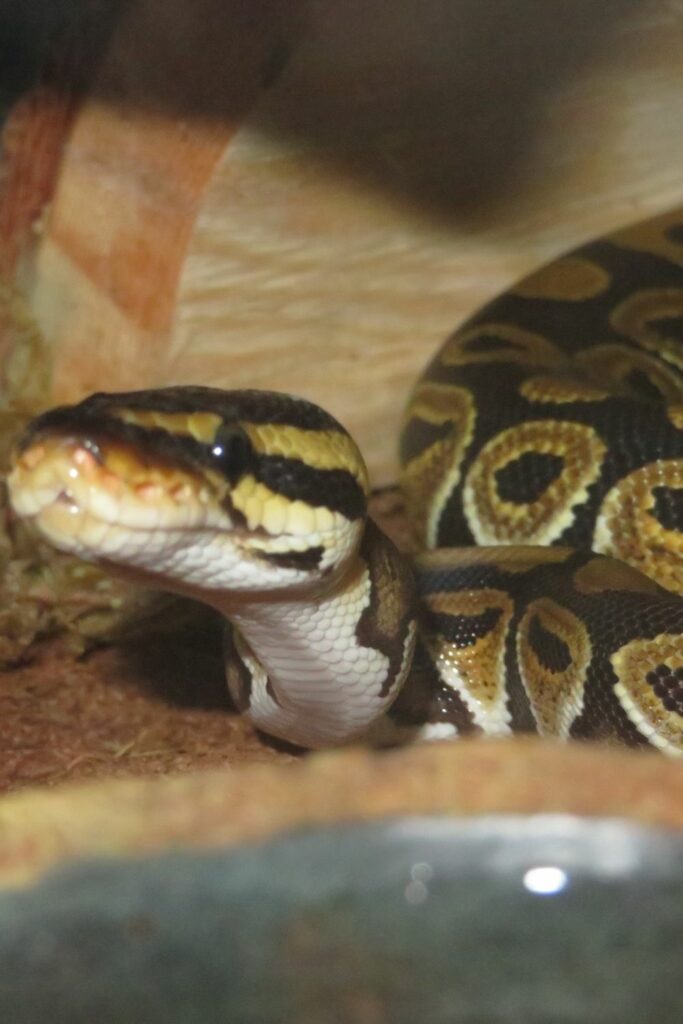
Mice and Rats
These are the primary staples for Ball Pythons. Both can be offered either live or pre-killed, though many experts recommend frozen-thawed for safety reasons.
Chicks and Quail
While not as common, some snake keepers introduce these birds as an occasional variety in the diet. However, they shouldn’t replace rodents as the primary food source.
Safe Handling and Feeding of Prey Items
Frozen-Thawed vs. Live
Feeding frozen-thawed prey reduces the risk of injury to the snake. If choosing this option, ensure the prey is completely thawed and warmed slightly before feeding.
Use Tongs
Always use feeding tongs to offer the prey. This ensures a safe distance between your hand and the snake, reducing the risk of accidental bites.
Separate Feeding Area
While not essential, some keepers prefer to have a separate feeding area to prevent the snake from associating their main habitat with feeding times.
Frequency and Portion Control Based on Snake’s Size and Age
- Juveniles: Younger snakes have a faster metabolism and thus require feeding more frequently, typically every 5-7 days.
- Adults: As they grow, their feeding frequency can be reduced to once every 7-14 days, depending on the snake’s size and the prey’s size.
- Size Matters: The prey item should be roughly the same width as the widest part of the snake’s body. Overfeeding or offering too large a prey can lead to health issues.
Access to Fresh Water and Its Importance
- Always Available: Ensure fresh water is always accessible. Ball Pythons will drink as needed and may also occasionally soak, especially during shedding.
- Cleanliness: Regularly check and change the water to ensure it remains clean. This prevents bacterial buildup and potential health concerns.
According to a study published in the Journal of Herpetological Medicine and Surgery, a consistent and appropriate diet directly correlates with the overall health and lifespan of captive snakes.
The research highlighted the importance of portion control, prey variety, and the risks of overfeeding, solidifying the necessity of being meticulous with our reptilian companion’s dietary regimen.
In Conclusion🐍
Ensuring your Ball Python has a balanced, appropriate diet is fundamental to its health. By understanding their dietary needs and adapting as they grow, you set the stage for a long, healthy life for your snake.
Handling & Socialization
Interacting with your Ball Python goes beyond just feeding and observing. Proper handling and socialization are crucial not only for building a bond with your pet but also for its overall well-being.
Regular, gentle interactions can reduce stress, foster trust, and make routine checks or enclosure cleanings easier. Let’s explore the right way to approach this.
Best Practices for a Smooth Handling Experience
Start Slow
Especially with a new or young snake, begin with short, gentle handling sessions and gradually increase the duration as the snake becomes more accustomed.
Approach Gently
When reaching into the enclosure, approach the snake from the side rather than from above, which can be perceived as a threat.
Support the Body
Ensure that you support the snake’s body, especially the midsection, when handling. This helps them feel secure.
Avoid Handling After Feeding
Wait at least 48 hours after feeding before handling your Ball Python. Handling too soon after a meal can cause regurgitation.
Minimize Sudden Movements
Quick or jerky movements can startle your snake. When handling, maintain calm and deliberate actions.
Tips to Foster Trust and Regular Interaction Benefits
Routine
Establishing a routine can be beneficial. Handling your snake around the same time or under consistent conditions can make the process predictable and less stressful.
Positive Reinforcement
Over time, your snake will associate handling with positive experiences. Ensuring each interaction is calm and gentle is vital.
Observation
Spend time observing your Ball Python in its enclosure. This not only helps you understand its behaviors but also lets the snake get used to your presence.
Safety Measures for Both the Snake and Handler
- Wash Your Hands: Always wash your hands before and after handling to prevent any potential transfer of contaminants or germs.
- Avoid the Head: While Ball Pythons are generally docile, it’s good practice to steer clear of the head area, especially if the snake isn’t accustomed to handling.
- Be Aware of Surroundings: Ensure there are no potential hazards in the area where you’re handling your snake, such as other pets or sharp objects.
- Know When to Step Back: If your snake displays signs of stress or aggression—like hissing, striking, or tightly coiling—it’s best to give it some space and try handling another day.
Forming a bond with your Ball Python is one of the most rewarding aspects of reptile ownership. It’s a relationship built on mutual respect and understanding. With time, patience, and consistent positive interactions, your snake will come to see you less as a potential threat and more as a source of security and comfort.
Health & Wellness
Keeping your Ball Python in optimal health goes beyond basic care and feeding. It requires vigilance, a keen eye for observation, and a proactive approach to preventive care.
As with all pets, the sooner potential health issues are identified and addressed, the better the outcome. Let’s explore how to ensure your Ball Python remains healthy and vibrant throughout its life.
Identifying Symptoms of Prevalent Health Issues
Respiratory Infections
Signs include wheezing, mucus around the nostrils, and increased open-mouth breathing. This could be due to overly low or high humidity levels or exposure to drafts.
Mites and Ticks
Tiny black or red parasites can be found on the snake or in its enclosure. They can cause stress and potential infections.
Scale Rot
Discolored, softened, or blistered scales, typically on the snake’s underside, indicate scale rot, often a result of overly wet or unsanitary conditions.
Mouth Rot
White, cheesy deposits around the mouth, swollen gums, or reluctance to eat can be indicative of stomatitis or mouth rot.
Digestive Issues
Regurgitation or constipation can be signs of overfeeding, feeding prey that’s too large, or incorrect temperatures in the enclosure.
Understanding the Shedding Process in Ball Pythons
Shedding, or ecdysis, is a natural process that Ball Pythons undergo as they grow. Here’s how it typically unfolds:
- Pre-shedding Signs: The snake’s skin becomes dull, and its eyes might turn a milky blue. They might also become more reclusive.
- The Actual Shed: A healthy Ball Python will shed its skin in one long, continuous piece. Ensure humidity levels are slightly elevated during this period to facilitate the process.
- Post-shed: Inspect the shed skin for any retained pieces, especially around the eyes or tail tip. Any retained shed can cause issues and should be addressed.
Regular Health Checks and Preventive Care
- Visual Inspections: Regularly observe your snake for any physical abnormalities or behavioral changes.
- Weight Monitoring: While weighing your snake might not be necessary every week, periodic checks can help spot sudden weight gain or loss, which could indicate health concerns.
- Clean Environment: Ensure the enclosure remains clean, removing waste promptly and periodically changing the substrate.
Recognizing When Professional Vet Intervention is Required
- Prolonged Issues: If you notice any health symptoms that persist or worsen over time, it’s essential to consult a vet.
- Behavioral Changes: A sudden change in behavior, like prolonged fasting or lethargy, might indicate underlying health issues.
- Physical Abnormalities: Swellings, wounds, or any deformities should be checked by a professional.
According to a review published in the Journal of Exotic Pet Medicine, captive Ball Pythons tend to live healthier lives than their wild counterparts due to controlled environments.
They can still face a range of health issues stemming from dietary imbalances, suboptimal housing conditions, or lack of preventive care. This highlights the significance of ongoing education and attentiveness for pet owners.
In Essence🐍
Being proactive, observant, and informed about potential health concerns is key to ensuring your Ball Python leads a happy, healthy life. When in doubt, always consult with a reptile veterinarian to ensure your snake gets the best care possible.
Breeding & Reproduction
Breeding Ball Pythons can be a rewarding experience, offering a unique opportunity to observe the full life cycle of these fascinating reptiles. However, it’s a decision that comes with its own set of responsibilities and challenges.
Let’s journey through the key aspects of Ball Python breeding, from pre-breeding preparations to caring for newly hatched snakes.
Pre-breeding Considerations and Preparations
Age and Size
It’s crucial to ensure that both male and female pythons are of appropriate age and size. Females should ideally be at least three years old and weigh around 1500 grams, while males can start breeding at around two years or 600 grams.
Health
Both snakes should be in optimal health. Any underlying health issues can impact breeding success or the health of the offspring.
Brumation
Though not strictly necessary for Ball Pythons, some breeders choose to simulate a winter cooling period, known as brumation, to encourage breeding behaviors.
Diet
In the lead-up to breeding, it’s advisable to slightly increase the female’s food intake to ensure she has enough energy reserves for egg production.
The Egg-laying Process, Incubation, and Post-hatch Care
Ovulation and Laying
After a successful mating, you’ll notice the female’s midsection swelling, indicating ovulation. Eggs will typically be laid 30 to 45 days post ovulation. A clutch can contain anywhere from 3 to 11 eggs.
Incubation
Eggs should be carefully placed in an incubation medium like vermiculite or perlite, maintaining a humidity of about 90% and a temperature of 88°F to 90°F. Incubation usually lasts around 55 to 60 days.
Post-hatch
Once the snakes begin to hatch, it’s crucial not to rush the process. Snakes will often remain in their eggs for a day or two, absorbing the remaining yolk. Only remove them once they’ve fully emerged.
Managing Hatchlings and Understanding Their Early Needs
- First Shed: Hatchlings will undergo their first shed about a week after hatching. Post-shed is generally when they’ll have their first meal.
- Feeding: Start with smaller prey items, like pinky mice. Regular feeding is essential for their rapid growth during these early stages.
- Housing: Hatchlings can be housed in smaller containers, ensuring they have adequate warmth and humidity. This enclosed space often makes them feel more secure.
- Handling: It’s advisable to limit handling in the very early stages to allow the hatchlings to acclimate to their new surroundings and reduce stress.
In Conclusion🐍
Breeding Ball Pythons, while rewarding, requires a deep understanding of their reproductive cycle, needs, and potential challenges. By ensuring optimal conditions, understanding the key milestones in the reproduction process, and providing dedicated care to hatchlings, breeders can nurture a new generation of healthy, vibrant Ball Pythons.
Tips for Longevity & Happiness
Ensuring that your Ball Python leads a long, contented life isn’t just about meeting its basic needs—it’s about understanding, engaging with, and responding to the snake on a deeper level.
Longevity and happiness go hand-in-hand, and as caretakers, we have the responsibility to provide an environment that promotes both. Let’s explore some essential pointers.
Debunking Common Myths and Addressing Frequent Care Mistakes
Myth: Ball Pythons are Aggressive
Despite their imposing name, Ball Pythons are among the most docile of snake species. Their name originates from their tendency to curl into a ball when threatened.
Mistake: Overfeeding
While it’s essential to ensure your snake gets enough nutrition, overfeeding can lead to obesity and related health problems.
Myth: A Bigger Enclosure is Always Better
While space is essential, too large an enclosure can make a Ball Python feel insecure. It’s more about creating the right environment within the space.
Mistake: Inconsistent Temperatures
Fluctuating or extreme temperatures can stress your snake and lead to health complications.
Enrichment Ideas and Activities Tailored for Ball Pythons
- Exploration Opportunities: Providing new items or occasionally rearranging the enclosure can pique your python’s curiosity and provide mental stimulation.
- Climbing Structures: While they’re not arboreal, Ball Pythons will occasionally explore vertically. Offering branches or other climbable structures can add a new dimension to their environment.
- Interactive Feeding: Instead of always leaving food in the same spot, you can make feeding time more engaging by making your snake ‘hunt’ or explore for its food.
Observing and Interpreting Behavioral Cues and Moods
- Hiding: If your Ball Python is consistently hiding and not emerging even during the night, it might be an indication of stress or discomfort.
- Tongue Flicking: When your snake flicks its tongue, it’s sensing its environment. Rapid tongue flicking can indicate curiosity or alertness.
- Coiling or Hissing: These can be signs of feeling threatened or defensive. You must approach your snake calmly and gently, ensuring you don’t startle it.
- Inactivity or Refusal to Eat: While Ball Pythons are known for their occasional fasting, prolonged inactivity or consistent refusal to eat could be signs of an underlying health issue.
A happy Ball Python is one that feels secure, stimulated, and well-understood by its owner. By debunking myths, avoiding common mistakes, and consistently engaging with and observing your snake, you can ensure that your Ball Python enjoys a life marked by contentment and health.
Remember, longevity isn’t just about years lived, but the quality of those years.

